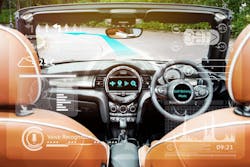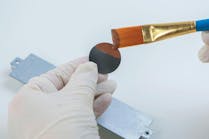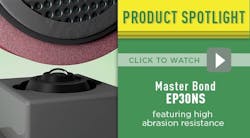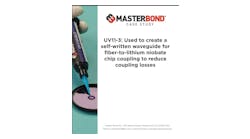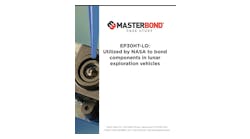New UV adhesives improve the integration of holographic films in augmented reality HUDs
Windach, 17 February 2022 | DELO has developed DELO PHOTOBOND UV acrylates for optoelectronics that enable fast and true-color bonding of holographic films manufactured by Covestro, one of the leading suppliers of films for holographic applications. The automotive industry, as well as many others, will benefit from rapid roll-to-roll manufacturing and better integration of the films into holographic end-use applications.
Augmented reality head-up displays (AR-HUDs) represent one of the most important future applications for holographic films, like Bayfol® HX from Covestro. As these films are integrated into the windshield, projections merge with reality so that the navigation appears to be displayed directly on the road. The films allow for brighter and larger images while reducing installation space.
This holographic film technology also offers design freedom and reduced space requirements in the rear lights of cars and other automotive lighting applications. Customized holograms, like a warning message that says ‘Stop’ in the driver’s field of vision, can be designed to increase safety.
No matter the application, holographic films are thin, lightweight and completely invisible under so-called off-bragg conditions – whenever the coupled light does not meet certain requirements, like the correct wavelength. The films usually consist of RGB-sensitive photopolymers on a transparent carrier film and are embedded between two protective cover layers.
Low optical interaction, high strength
A precondition for high component quality is low optical interaction between adhesive and photopolymer. Because of this, the adhesives are chemically adapted in such a way that they do not shift the absorption into other wavelength ranges when they are combined with the photopolymer. Therefore, they must ensure color fidelity under all conditions.
Until now, mainly silicones have been used to fix the film layers. Silicones are versatile and high-performance materials; however, this is offset by lower strength, slower curing and, in some cases, strong outgassing. During curing, they emit particles to their surroundings. Due to the potential impact on adjacent manufacturing processes, many automotive suppliers are striving for silicone-free production. The DELO PHOTOBOND UV acrylates tested by DELO and Covestro show a highly improved outgassing behavior compared to silicones and reach full strength within seconds under UV light.
"Our holographic films have the potential to push the existing boundaries of automotive lighting capabilities," says Richard Meisenheimer, Application Development Holographic LightGuiding at Covestro. "With UV adhesives, DELO gives our customers another manufacturing option and helps them process the products in their application."
